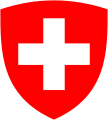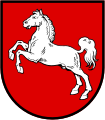Heraldic figure
Heraldic figure or heraldic image , also just a figure , is a collective term for all representations used in heraldry on the heraldic shield .
A distinction is made in the coat of arms between the common figure and the herald image . The common figures do not run into the edge of the shield ; This distinguishes it from the heraldic images.
Common figures are all natural things from the animal and plant kingdom or heavenly bodies. The things of daily life, like those from the handicraft and the arts, the agriculture, but also the warfare belong here. The imagined and fictional common figures are all mythical creatures, for example. The choice is huge here: unicorn , dragon , griffin , harpy , to name a few. The letters or words shown in coats of arms in modern times are also included in this group.
The varied shape of the cross occupies a middle position. If these touch the edge of the shield with all four arms, then they are heraldic images. If at least one cross arm is free, it is a mean figure.
The common figure is subject to some heraldic rules: The figure is based on the space in which it stands and fills it out if possible. Common figures can also be represented as parts (head, upper or front part, claw, wing) in the coat of arms. They can be covered or sown with other common figures. Combinations with images of heralds also occur.
When it comes to blazon , the most varied of terms are used to make a clear statement. They enable a good draftsman with heraldic knowledge to create a coat of arms according to the description.
Examples
Common figure
Sachsenross in the coat of arms of Lower Saxony
Federal eagle in the federal coat of arms of Germany
Heraldic figure
Saint George's Cross in the coat of arms of Milan
A blue bar in the coat of arms of the canton of Zug
Landsberg stakes in the coat of arms of the Mark Landsberg
Saint George's Cross , blue wave bars and red diamonds are sparse in the coat of arms of the Paderborn district
literature
- Gert Oswald : Lexicon of Heraldry. Bibliographical Institute, Mannheim / Vienna / Zurich / Leipzig 1984, ISBN 3-411-02149-7 , p. 151, 129.







